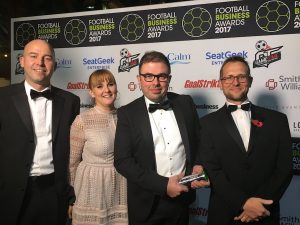SVG Europe Sit-Down: Supponor’s Charlie Marshall with AR digital replacement insights

Charlie Marshall, Chief Operating Officer, Supponor
Based in London and Helsinki, Supponor uses pioneering technology to deliver powerful brand activation in broadcast sport. Supponor solutions have been deployed for a broad range of Tier 1 sports – most notably football, but also hockey, basketball, motor racing and American football. Those solutions employ a virtualised and targeted augmented reality messaging platform to maximise the value of TV-visible in-venue branding. SVG Europe began its Sit Down with Charlie Marshall, Chief Operating Officer of Supponor by setting the scene of the company’s activities…
For those unfamiliar with augmented reality digital replacement, can you tell us briefly what this entails?
In essence, it’s the real-time replacement of physical signage that appears in live sports broadcasts with authentic digital, or virtual, overlays. These virtual overlays are designed – from both technical and creative content perspectives – to look like they are at the venue, thus creating an integrated and respectful on-screen proposition for rights owners, their distribution partners and, of course, the sponsors and brands. In other words, companies who so often utilise this kind of signage – physically or virtually – to engage with fans around the sport that they love.
We refer to the technology as Augmented Reality, as it enhances something that is physically real, rather than generating pure graphical inserts without reference to real objects.
So, just how ‘targeted’ can the messages be produced?
From the word go, we have designed and built our technology solution so that the virtual overlays are the very last element of the video composition to be inserted. This makes the solution highly scalable, in that any number of targeted overlay feeds can be produced without having to overload the upstream workflow with multiple graphics engines and complex switching. As long as we can create the right metadata from the cameras and the vision mixers, including the match graphics, we can do the actual modification of programme feeds wherever we like – be that in an MCR, a network operating centre or on an IP connected device like a set top box or a tablet.
Presently, we find that the level of targeting required by our customers tends to map on to the key geographic audiences for their sport – where sponsor and advertiser demand is high. So, for example, when our technology is used in FC Barcelona and Real Madrid games in LaLiga, at least 8 feeds are being produced and routed to the relevant broadcasters around the world, focusing on regions such as Asia, Latin America, Middle East and North Africa, Sub Saharan Africa and even specific territories such as Mexico and Turkey.
You can see Supponor’s technology in action in LaLiga at https://www.youtube.com/watch?v=JpCuIahlvR0.
In the future, we see a world where the targeting of augmented reality digital replacement content in sport is much more personal, employing the kinds of data models and ad-tech technologies that are increasingly common in most other digital content sectors today.
In September, you announced that the English Premier League and EFL were adopting your next generation solutions? What does this involve?

Advanced technology enables real-time replacement of physical signage with authentic digital, or virtual, overlays.
To ensure that the quality – or authenticity – of the AR replacement content is high enough to be deployed into live broadcast images of the most valuable content on the planet, both stadium and broadcast technologies have to be made ready. For sports like football where fully animated LED signage systems are a key commercial asset in the physical world, this means we have to work with the clubs and their LED providers to ensure that we can integrate with the physical systems to deliver authentic replicas of the content in the virtual world.
Our first major LED partner was ADI, one of Europe’s leading names in sports venue fan engagement platforms. ADI supplies a large number of EPL and EFL clubs with their LED systems and content. Following our successful 2016/17 season project with ADI to install, test and market the first fully productised LED Virtual ‘hybrid’ system at EPL club Watford FC), we have recently been encouraged to see a number of other clubs – such as Everton in the EPL and Derby County in the EFL – make moves to adopt the technology as a way of paving the way for future deployments.
This does not mean that every broadcast from these clubs will now feature AR signage. That’s because the frameworks for commercial deployment still need to come together through, for example, agreement between clubs, leagues and broadcasters. However, it does mean that when these frameworks materialise, the early adopter clubs will be ready to deploy, from a technical standpoint, straight away.
It is Supponor’s strategy to continue to work with the various players in the value chain – for instance, LED companies, facilities providers, broadcasters and, of course, the ultimate rights owners like clubs and leagues – to make adopting Supponor’s technology a standard part of industry upgrade cycles. And I’m pleased to say that – because there is value to be captured in the short term – this strategy is working. We were thrilled to win Best Technology 2017 at the recent Football Business Awards in the UK for our efforts.

The Supponor and ADI teams won the prestigious Football Business Awards 2017 Sports Technology of 2017 award in November.
Whilst we, along with some other technology companies, continue to experiment with certain ‘lighter touch’ technologies that require less change to infrastructure, there is no clear sign right now that any such technology can work to the levels and flexibility required by top tier sports properties for full commercial deployment.
How does the system work? Do you take the cut feed from the broadcaster and then add in your replacement according to a predetermined schedule?
Without going into the finer technical details, we effectively use proprietary methods to create a robust and highly accurate key signal to replace pixels representing background surfaces in live video, irrespective of foreground occlusions and or other types of graphics overlays that may appear in the broadcast.
Technology features such as camera tracking, masking of occlusions and handling of match graphics need to be of the highest possible accuracy in ever changing circumstances, where colours, environmental conditions and vision mixing are inherently unpredictable. Our system is based on a variety of underlying technologies, such as infrared optics, to ensure that this is the case.
We insert our virtual content ‘post mixer’ or ‘post switcher’, which requires a further set of technical system attributes to do reliably, but, in turn, creates greater scalability for rights owners and less complexity for broadcasters.
Can you tell us a little about your involvement with the SME Instrument programme that falls under the umbrella of Horizon 2020 – the EU Framework Programme for Research and Innovation – and how things are progressing?
We have the honour of being one of the SMEs in the Horizon 2020 programme. This means we benefit from a range of financial and non-financial support mechanisms to help us achieve on of our core business objectives of increasing scalability. We are currently nearing the end of a 3-year project to develop and launch the next generation of our optics technology – we’re hugely excited about the impact this will have on the market and our business.
More details can be found at https://www.svgeurope.org/blog/headlines/supponors-charlie-marshall-discusses-impact-of-eu-horizon-2020-sme-instrument-scheme-on-innovative-camera-project/.
How has the increase in OTT impacted your solutions?
As mentioned earlier, from a technical perspective we’re always designing and building our solutions to take full advantage of the capabilities of any distribution platform. With OTT, we move into an IP driven world which means our content insertion can start to happen further towards the end user, for example on consumer devices. We demonstrated a beta product showcasing in browser insertion and interactivity at the NHL’s World Cup of Hockey last season to great effect.
In the short term, the majority of sports content consumption is still of live broadcast programming, whether on satellite, cable or OTT platforms, so we haven’t moved too far from the traditional model of finishing content in trucks or MCRs. But change is never far away, especially with the adoption of more remote production technologies, as much with OTT distribution and consumption of content.
Have you a European sports-related case study you can share with us?
While we continue to deploy our technology on a weekly basis with our partner Mediapro in Spain, at every FC Barcelona and Real Madrid away match, we are also now expanding to new markets. Back in May we put on a live demonstration as part of our development work in the Bundesliga, working with a range of partners to deploy our LED compatible AR digital replacement system at a match between Frankfurt and Wolfsburg. More on this can be read at https://www.svgeurope.org/blog/headlines/adi-and-supponor-collaborate-on-live-ad-integration-milestone-at-bundesliga-match/.

